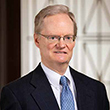Ask an Economist
David Wheelock, vice president and economist at the St. Louis Fed, is deputy director of the Research division. His research interests are financial and monetary history—especially the Great Depression—and banking. His outside interests include traveling, playing trumpet in the University City Symphony Orchestra and helping to coach his son's sports teams. For more on Wheelock's work, see http://research.stlouisfed.org/econ/wheelock/
Q. Does the Fed's regional structure play a role in monetary policy?
A.The regional structure of the Federal Reserve System plays an important role in determining U.S. monetary policy. The Federal Open Market Committee (FOMC), which is the Fed's primary monetary policymaking body, is comprised of all members of the Fed's Board of Governors and five of the 12 Reserve bank presidents. The president of the Federal Reserve Bank of New York is a permanent member of the FOMC, while the presidents of the other Reserve banks serve as members on a rotating basis. However, all 12 Reserve bank presidents participate in the committee's deliberations; those who are not currently voting members contribute as much to the discussion around the FOMC table as those who are. At the meetings, the presidents report on economic conditions in their districts and offer their views and perspectives on appropriate monetary policy.
In addition to helping bring information about economic conditions throughout the country to bear in setting policy, the Fed's regional structure contributes to the deliberative process by giving a voice to diverse views about policy that come from the economic research functions of the Reserve banks. Each Reserve bank has a staff of economists who support their president in his or her role on the FOMC. Having 13 different research divisions throughout the system (including that of the Board of Governors) facilitates a healthy competition of ideas. For example, in the 1960s and 1970s, the president of the Federal Reserve Bank of St. Louis, with supporting research by his staff economists, challenged the conventional wisdom about the cause of inflation. He argued that monetary policy alone is responsible for determining a country's long-term rate of inflation. The Fed's regional structure enabled the St. Louis Fed president's views to be heard at the FOMC table, and eventually his views became the conventional wisdom.
As the example shows, the structure of the Fed promotes a diversity of views and helps to avoid a groupthink mentality. Ultimately, this helps bring about better monetary policymaking.
Views expressed in Regional Economist are not necessarily those of the St. Louis Fed or Federal Reserve System.
For the latest insights from our economists and other St. Louis Fed experts, visit On the Economy and subscribe.
Email Us


